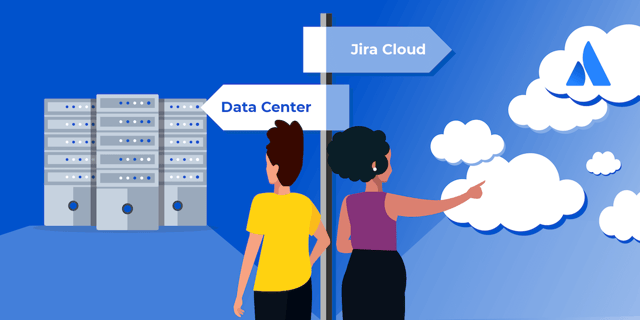Are you ready for Jira Cloud or Data Center?

Atlassian released some rather interesting news regarding the end of sales for Jira Server licenses, along with an increase in the price of Data Center from 2 February 2021. With Server support also ending in 2024 – and a lot of organizations still using it – it is crucial to make the right decision moving forward. Here are the most important things to consider…
Security in the cloud
The most relevant issue and concern for many we have talked with is regarding security and data residency in the cloud. Having your data stored externally is, and should be, a security concern for many organizations – especially if data is stored across borders and the expected rules and regulations no longer apply.
GDPR
In Europe we have the GDPR rules, which specify how data regarding EU citizens should be handled. It is important to remember that the scope of these rules are not confined to the EU, but are also valid for the handling of EU citizen data in any other countries. This is relevant because Atlassian may host your data all around the world.
.png?width=600&name=map%20atlassian%20cloud%20vs%20dc%20(1).png) Source: https://www.atlassian.com/trust/reliability/infrastructure
Source: https://www.atlassian.com/trust/reliability/infrastructure
The fines for violating the GDPR are very high; and if a company is earning enough, it is based on a percentage of their global revenue. This is a very strong incentive for a lot of organizations to do their very best to comply with GDPR. Atlassian is in the same boat in this regard.
Privacy Shield
Regarding personal data transfer between the EU and the US, there used to be one other standard, called Privacy Shield. However, this was ruled invalid as of 16 July 2020 by the European Court of Justice, as the data protection was not good enough to comply with the EU rules.
This means that while Atlassian still adheres to the rules and obligations of Privacy Shield, it is no longer enough if you want to transfer personal data from the EU to the US.

Where will my data be kept?
If you have the Enterprise license, you get limited control: you will be allowed to select whether your data is stored within Europe or North America. Note that this does not include any data handled by plugins – we’ll come on to that later in this blog.
This may be enough for some. But if you are a government organization or are working with financial information, then this would likely be the deciding factor and you would be limited to Data Center.
Also note that your Atlassian account is tied to Atlassian and not your instance. Therefore the data residency control is not related to the accounts themselves, but only the data you store in the instance.
Organization size
 Another important factor to consider is your organization size. Your size determines what options you have for data residency since the enterprise license required for data residency control is only available for licenses with at least 1,000 users.
Another important factor to consider is your organization size. Your size determines what options you have for data residency since the enterprise license required for data residency control is only available for licenses with at least 1,000 users.
For Jira Service Management you need at least 300 licenses as well. I expect this to change in the future since this is a huge problem for smaller organizations that would be dependent on data residency control. If you are one of them, please vote on the related Atlassian tickets here and here.
The maximum number of users in the Cloud is 10,000. This is likely enough for a lot of different organizations, but remember that this is currently a hard limit and should be taken into consideration.
My prediction is that Atlassian will push to make sure even more users can share an instance, and I’m hoping they will make it infinitely scalable at some point as well. We will likely see a beta program open up for 10,000+ instances soon, just as they did for the previous maximum tier. But we will have to wait and see.
Plugins
 If none of the above proved to be a deciding factor, then the next important step for you would be to verify your plugins and any external/internal integrations you or your team has made.
If none of the above proved to be a deciding factor, then the next important step for you would be to verify your plugins and any external/internal integrations you or your team has made.
Plugins from the Atlassian Marketplace have become much more available in the Cloud recently due to the push from Atlassian. But there are still a few cases where the plugin vendors did not have the time, motivation or necessary tools to recreate their plugins in the Cloud. Even if they did, there is also no guarantee that they made a migration process for your data to move it to the Cloud.
Most of the Atlassian plugin vendors I have spoken with have been very helpful regarding any migrations, and I have noticed that almost all of the complex functions of the plugin Scriptrunner are also now available in the Cloud (although some assembly may still be required).
A lot of the vendors are also working together with Atlassian to make their plugin compatible with the Cloud Migration Assistant. This feature should be available around Q2 2021.
Regarding data residency, you must also remember that while there are specific rules from Atlassian which all vendors must follow, they may have your data stored on their own servers in a location you had not intended.
My recommendation is to contact the vendor if you suspect any issues. They might even be able to assist if there are specific areas where you would need higher security.
User management and LDAP/AD integration
 There is currently no native LDAP/AD integration in the Cloud. This means there is no easy way to utilize your own local custom Active Directory server if you have one. Instead you can use Atlassian Access to provision users from other cloud identity providers. Only users with emails existing in the identity provider (i.e. company emails) will be synchronized.
There is currently no native LDAP/AD integration in the Cloud. This means there is no easy way to utilize your own local custom Active Directory server if you have one. Instead you can use Atlassian Access to provision users from other cloud identity providers. Only users with emails existing in the identity provider (i.e. company emails) will be synchronized.
So for example, you could use Azure AD or Google Cloud to handle your users. Keep in mind that Atlassian Access is an extra subscription on top of your other Cloud subscriptions and the cost is based on your total number of users.
Another important thing to be aware of is that if you want to use any Atlassian Access policies like MFA together with Atlassian Access, then you have to control and own the domains where this is enforced. In this case external consultants or clients in your system would not be able to use the email from their own organization, but would need a new email and account from your domain instead.
Cloud UI/UX differences
 Finally, you may also want to consider if the new issue view would give you any problems during or after migration.
Finally, you may also want to consider if the new issue view would give you any problems during or after migration.
It is in many ways similar to what you might be used to on Server/Data Center, but there are some key changes to be aware of and the new issue view will be mandatory after 31 March 2021 for Cloud.
In most cases this would not be the deciding factor, but it can create new challenges if you are used to showing information in a certain way. Custom fields are now hidden in the bottom right corner and there is only one Screen instead of three to configure.
Which journey to choose?
 I hope this blog has illuminated some of the common issues, challenges and solutions you may face in the future, and will help you when taking the next steps.
I hope this blog has illuminated some of the common issues, challenges and solutions you may face in the future, and will help you when taking the next steps.
There is also a small quiz from Atlassian you can take if you are still in doubt, as well as a cost calculator for Cloud prices.
My personal opinion is that Cloud should be your preferred destination. Not because Atlassian wants it to be, but because there are many benefits of having Jira as a service in the Cloud.
Besides the obvious ones like server maintenance, automatic updates and uptime, the fact that almost all other software companies are moving their services to the Cloud as well means that it will be easy for them to integrate and communicate – and the chance of you ending up with technical debt or legacy systems is minimal.
Despite that, there are still obvious problems that have not been solved in the Cloud and in those cases Data Center would be the right way to go. Since we do not yet fully know what plans Atlassian has for Data Center in the future, I would also keep a close eye on the Data Center roadmap. I hope it will not be relevant but it would make sense to consider what would happen if Atlassian decides to discontinue Data Center in the far future as well.
If you would like to know more about the actual migration process, I recommend checking out the excellent Jira Cloud migration blog.
And if you have any questions that I didn’t cover above, you are also welcome to contact me at thomas.hargreaves@eficode.com. I would be delighted to answer anything you would like to know regarding the new Atlassian changes and what this means for you and your organization.
Published:
Updated:


